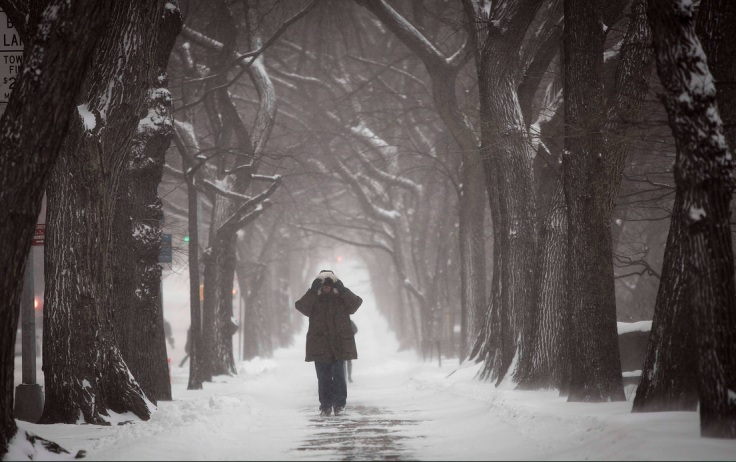Polar Vortex And Climate Change: Why Cold Weather Doesn't Disprove Global Warming

There’s nothing like a blast of winter weather to bring climate change skeptics out of the woodwork, asking if global warming can really exist if it’s cold outside. But most climate scientists will tell you that a warming climate does not mean that a period of eternal summer descends across the planet.
No matter what climate trends are on Earth, we will still have seasons thanks to the tilted axis of our planet, which at present is tipping the Northern Hemisphere away from the sun, giving us shorter days. Since sunlight is hitting the northern half of the globe at a different angle, we don’t get the full blast of its light and heat, leading to drops in temperature. (Meanwhile, in a summery Southern Hemisphere, Australia is looking at temperatures soaring above 100 degrees Fahrenheit next weekend.)
Furthermore, scientists routinely emphasize that weather is a much different thing from climate.
“Weather is what’s happening outside the door right now; today a snowstorm or a thunderstorm is approaching,” the Union of Concerned Scientists says. “Climate, on the other hand, is the pattern of weather measured over decades.”
And while occasional cold snaps and blizzards still occur, winters in the U.S. have been getting warmer and warmer. A February 2013 report from Climate Central found that winter warming has been accelerating across almost all of the continental U.S since 1970. Over that same time period, winter nights have also been heating up -- in Wisconsin, Minnesota and Vermont, the average winter night in 2013 was five degrees Fahrenheit hotter than in 1970.
It is undoubtedly cold outside, of course. Right now, much of North America is in the grip of what’s called a “polar vortex” -- a giant swirling mass of cold air in the atmosphere. Normally, a vortex like this is confined to the Arctic, but its moving further south than usual -- and driving temperatures down to the negative 20s and negative 30s in the Midwest. That’s cold enough for boiling water thrown from a pot to turn into snow, as Wisconsin-based meteorologist Eric Holthaus demonstrates:
No one’s quite sure why this polar vortex is swinging down so far right now.
“This very well just may be one of those anomalies where [the polar vortex] forces itself southward,” Frank Giannasca, senior meteorologist with The Weather Channel, told NBC News.
Climate change may could be contributing to conditions that make it easy for the polar vortex to swing southward. Normally, the frigid polar vortex is fenced in by high pressure zones from all sides and a swirl of winds. But a rapidly warming Arctic -- thanks to sea ice loss, which exposes dark ocean water that absorbs heat better than ice -- could destabilize the pressure of the polar vortex and the “fence” around it, according to the UCS.
“This instability allows the cold Arctic air to break free and flow southward, where it collides with warmer, moisture-laden air,” UCS says. “This collision can produce severe winter weather in some regions and leave milder conditions in other parts of the northern hemisphere.”
Admittedly, the connection between the vortex and climate change is still uncertain, since rapid Arctic warming is a recent phenomenon. More studies will have to be done to confirm any connection.
Last month, weathermen did have some inkling that January was shaping up to be frigid thanks to changes involving the polar vortex. Washington Post meteorologist Rick Grow noted on New Year’s Eve that a phenomenon known as a “sudden stratospheric warming” was underway. Basically, rapidly warming air higher up in the atmosphere over the Arctic throws off the circulation around the north pole, allowing the polar vortex to stretch, or sometimes split apart (at present, the vortex seems to just be stretching).
In 2009, a trio of researchers wrote in the Journal of Climate [PDF] that these sudden stratospheric warming events seem to becoming more frequent in the Northern Hemisphere. They link the SSW events to an increase in the amount of snow cover across Europe and Asia in the fall. Snowier autumns in Eurasia, in turn, have been linked to the loss of Arctic sea ice, explains Climate Central: More open water up north in the fall means there is more atmospheric moisture around to fall back as snow.
Pundits frequently present a simplistic view of climate change just as a projected warming trend that can be falsified by a spot of cold weather. But as any brief foray into climate science will illustrate, weather is a complicated mechanism, and a changing climate may be fundamentally messing with the works in more ways than we know.
© Copyright IBTimes 2024. All rights reserved.





















